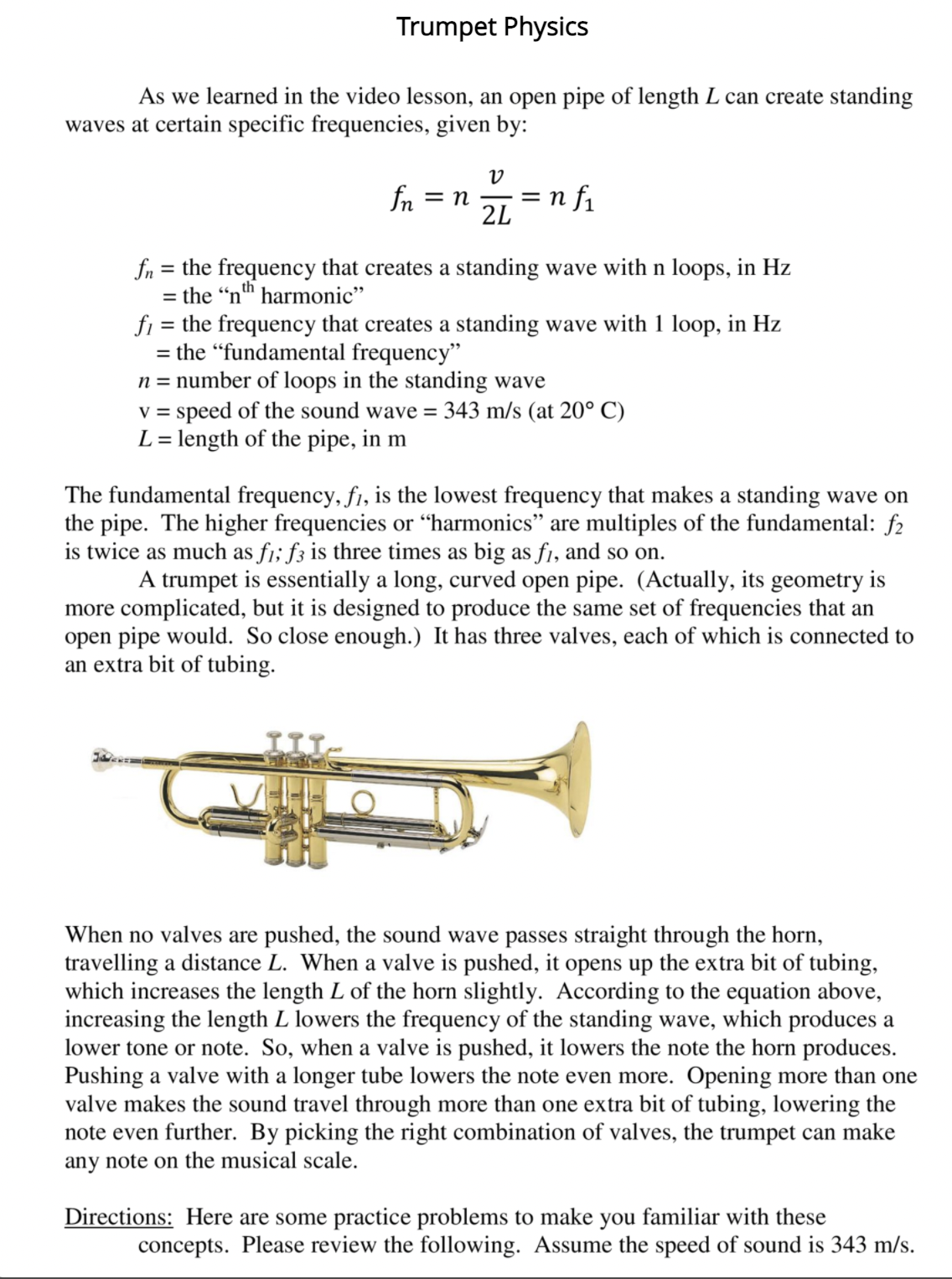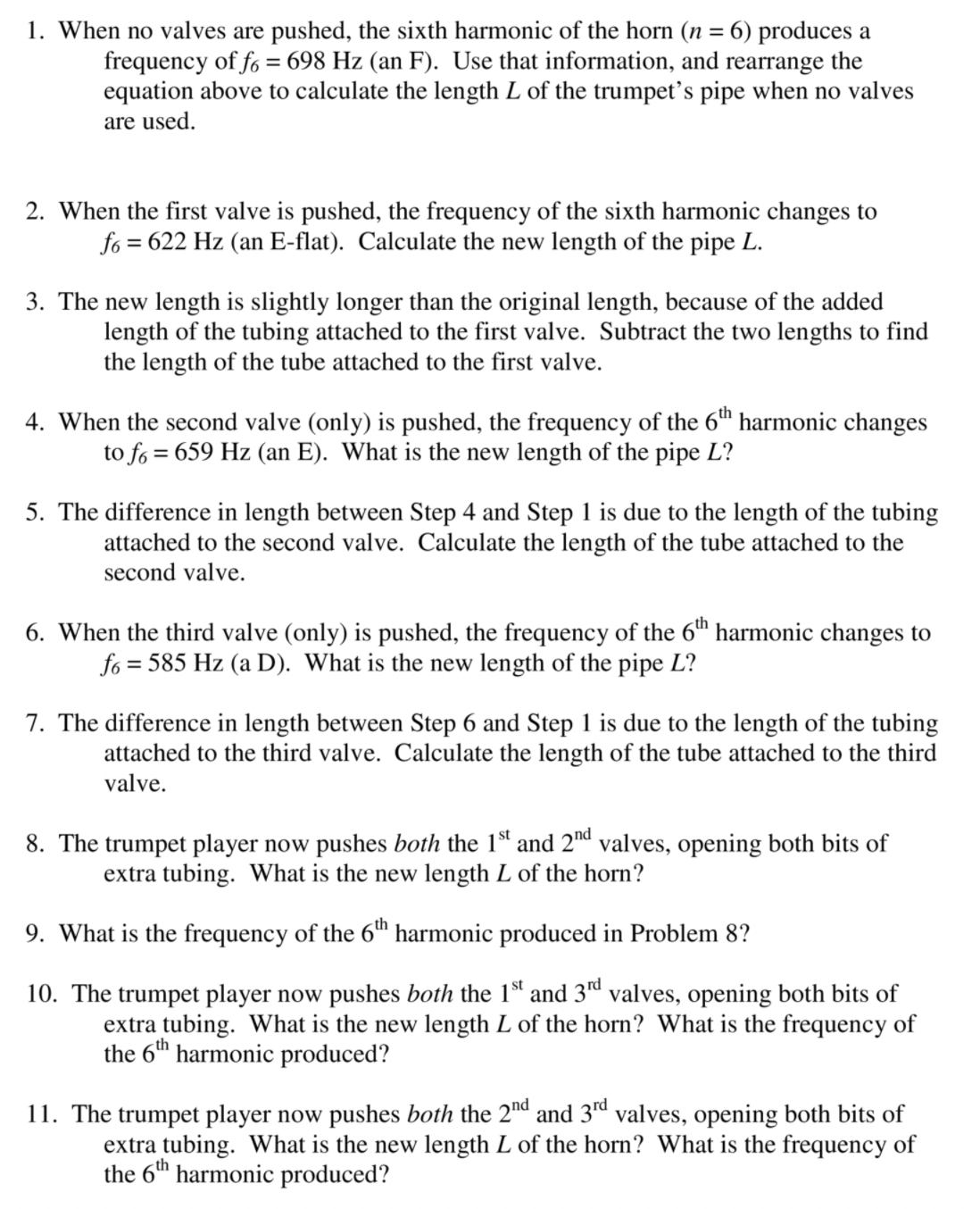2. When the first valve is pushed, the frequency of the sixth harmonic changes to fo = 622 Hz (an E-flat). Calculate the new length of the pipe L.
2. When the first valve is pushed, the frequency of the sixth harmonic changes to fo = 622 Hz (an E-flat). Calculate the new length of the pipe L.
An Introduction to Physical Science
14th Edition
ISBN:9781305079137
Author:James Shipman, Jerry D. Wilson, Charles A. Higgins, Omar Torres
Publisher:James Shipman, Jerry D. Wilson, Charles A. Higgins, Omar Torres
Chapter6: Waves And Sound
Section: Chapter Questions
Problem 6AYK
Related questions
Concept explainers
Interference of sound
Seiche
A seiche is an oscillating standing wave in a body of water. The term seiche pronounced saysh) can be understood by the sloshing of water back and forth in a swimming pool. The same phenomenon happens on a much larger scale in vast bodies of water including bays and lakes. A seizure can happen in any enclosed or semi-enclosed body of water.
Question
#2 in image 2

Transcribed Image Text:Trumpet Physics
As we learned in the video lesson, an open pipe of length L can create standing
waves at certain specific frequencies, given by:
fn
= n f1
2L
= n
fn = the frequency that creates a standing wave with n loops, in Hz
= the "nth harmonic"
fi = the frequency that creates a standing wave with 1 loop, in Hz
= the "fundamental frequency"
n = number of loops in the standing wave
v = speed of the sound wave = 343 m/s (at 20° C)
L= length of the pipe, in m
%3D
The fundamental frequency, f1, is the lowest frequency that makes a standing wave on
the pipe. The higher frequencies or “harmonics" are multiples of the fundamental: f2
is twice as much as f1; f3 is three times as big as f1, and so on.
A trumpet is essentially a long, curved open pipe. (Actually, its geometry is
more complicated, but it is designed to produce the same set of frequencies that an
open pipe would. So close enough.) It has three valves, each of which is connected to
an extra bit of tubing.
When no valves are pushed, the sound wave passes straight through the horn,
travelling a distance L. When a valve is pushed, it opens up the extra bit of tubing,
which increases the length L of the horn slightly. According to the equation above,
increasing the length L lowers the frequency of the standing wave, which produces a
lower tone or note. So, when a valve is pushed, it lowers the note the horn produces.
Pushing a valve with a longer tube lowers the note even more. Opening more than one
valve makes the sound travel through more than one extra bit of tubing, lowering the
note even further. By picking the right combination of valves, the trumpet can make
any note on the musical scale.
Directions: Here are some practice problems to make you familiar with these
concepts. Please review the following. Assume the speed of sound is 343 m/s.

Transcribed Image Text:1. When no valves are pushed, the sixth harmonic of the horn (n = 6) produces a
frequency of f6 = 698 Hz (an F). Use that information, and rearrange the
equation above to calculate the length L of the trumpet's pipe when no valves
are used.
2. When the first valve is pushed, the frequency of the sixth harmonic changes to
fo = 622 Hz (an E-flat). Calculate the new length of the pipe L.
3. The new length is slightly longer than the original length, because of the added
length of the tubing attached to the first valve. Subtract the two lengths to find
the length of the tube attached to the first valve.
4. When the second valve (only) is pushed, the frequency of the 6™ harmonic changes
to fo = 659 Hz (an E). What is the new length of the pipe L?
5. The difference in length between Step 4 and Step 1 is due to the length of the tubing
attached to the second valve. Calculate the length of the tube attached to the
second valve.
6. When the third valve (only) is pushed, the frequency of the 6th harmonic changes to
fo = 585 Hz (a D). What is the new length of the pipe L?
7. The difference in length between Step 6 and Step 1 is due to the length of the tubing
attached to the third valve. Calculate the length of the tube attached to the third
valve.
8. The trumpet player now pushes both the 1" and 2nd valves, opening both bits of
extra tubing. What is the new length L of the horn?
9. What is the frequency of the 6th harmonic produced in Problem 8?
10. The trumpet player now pushes both the 1st and 3ª valves, opening both bits of
extra tubing. What is the new length L of the horn? What is the frequency of
the 6th harmonic produced?
11. The trumpet player now pushes both the 2nd and 3d valves, opening both bits of
extra tubing. What is the new length L of the horn? What is the frequency of
the 6th harmonic produced?
Expert Solution
This question has been solved!
Explore an expertly crafted, step-by-step solution for a thorough understanding of key concepts.
Step by step
Solved in 2 steps with 1 images

Knowledge Booster
Learn more about
Need a deep-dive on the concept behind this application? Look no further. Learn more about this topic, physics and related others by exploring similar questions and additional content below.Recommended textbooks for you

An Introduction to Physical Science
Physics
ISBN:
9781305079137
Author:
James Shipman, Jerry D. Wilson, Charles A. Higgins, Omar Torres
Publisher:
Cengage Learning

Physics for Scientists and Engineers, Technology …
Physics
ISBN:
9781305116399
Author:
Raymond A. Serway, John W. Jewett
Publisher:
Cengage Learning

Physics for Scientists and Engineers
Physics
ISBN:
9781337553278
Author:
Raymond A. Serway, John W. Jewett
Publisher:
Cengage Learning

An Introduction to Physical Science
Physics
ISBN:
9781305079137
Author:
James Shipman, Jerry D. Wilson, Charles A. Higgins, Omar Torres
Publisher:
Cengage Learning

Physics for Scientists and Engineers, Technology …
Physics
ISBN:
9781305116399
Author:
Raymond A. Serway, John W. Jewett
Publisher:
Cengage Learning

Physics for Scientists and Engineers
Physics
ISBN:
9781337553278
Author:
Raymond A. Serway, John W. Jewett
Publisher:
Cengage Learning

Physics for Scientists and Engineers with Modern …
Physics
ISBN:
9781337553292
Author:
Raymond A. Serway, John W. Jewett
Publisher:
Cengage Learning

Principles of Physics: A Calculus-Based Text
Physics
ISBN:
9781133104261
Author:
Raymond A. Serway, John W. Jewett
Publisher:
Cengage Learning

University Physics Volume 1
Physics
ISBN:
9781938168277
Author:
William Moebs, Samuel J. Ling, Jeff Sanny
Publisher:
OpenStax - Rice University